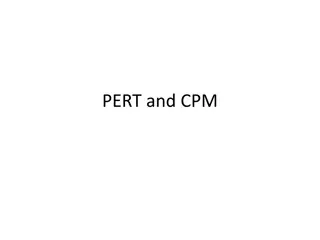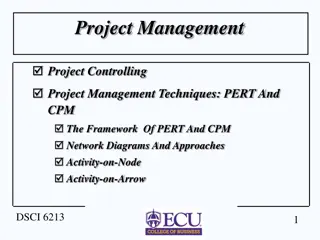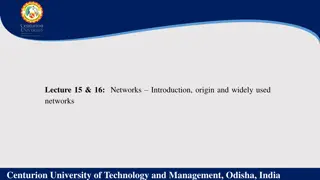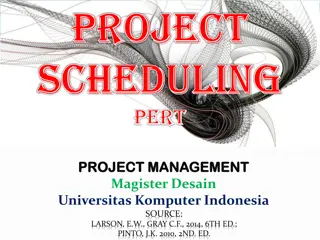Modern Project Management Techniques: PERT and CPM Explained
Delve into the world of project management with a focus on PERT and CPM techniques. Explore the framework, network diagrams, critical paths, scheduling, and control aspects. Learn how to identify precedence relationships, sequence activities, and manage resources effectively. Uncover the history, de
4 views • 14 slides
Understanding PERT and CPM Techniques in Project Management
Learn about PERT (Program Evaluation and Review Technique) and CPM (Critical Path Method) techniques used in project management. Discover how these methods help in coordinating activities, developing schedules, and monitoring project progress. Explore the applications of PERT and CPM in various indu
1 views • 166 slides
Project Management Techniques: PERT and CPM Overview
Explore the fundamentals of Project Management Techniques, focusing on PERT and CPM. Understand Network Diagrams, Forward and Backward Pass, Critical Path, Project Scheduling, and more. Learn about Gantt Charts, Six Steps of PERT & CPM, and their historical development in the 1950s. Gain insights in
7 views • 14 slides
Project Planning and Control Techniques: PERT/CPM Networks Overview
Project Evaluation and Review Technique (PERT) and Critical Path Method (CPM) are widely used project planning and control techniques, particularly for complex projects involving limited resources. PERT focuses on analyzing project scheduling problems using probability theory, while CPM provides a s
0 views • 6 slides
Understanding Project Management Terminology and Techniques
Explore the key concepts and methods in project management, such as expert judgment, analogous estimating, three-point estimates, and critical path analysis. Learn about hidden time factors, activity types, terminology paths, and network flow principles. Gain insights into historical development, in
1 views • 37 slides
Effective Media Strategy for Target Audience Reach
Understanding the audience, cost considerations, and media consumption patterns are crucial in developing an effective media strategy. It involves evaluating reach, frequency, CPM, CPP, GI, GRPs, and utilizing emerging media channels for maximum impact and allocation of media weight. The goal is to
0 views • 40 slides
Understanding Prosecution and Progress in Construction
Key features of a CPM schedule, resources required, schedule management, and job site activities are detailed in this informative content. It covers aspects like monitoring progress, determining controlling operations, submitting schedule updates, and initiating job site activities as per specificat
0 views • 40 slides
Tasks of Alignment and Installation in CEPC Project
Tasks involved in the alignment and installation optimization of components in the Circular Electron Positron Collider (CEPC) project include control network construction, component installation, smooth alignment, and addressing any arising problems. The process is crucial for the successful operati
2 views • 19 slides
The Digital Revolution in Advertising
Digital advertising is rapidly gaining dominance over traditional media, with spending outpacing other categories. It has reached a global market share of 41% in 2017, surpassing TV. Online advertising, including display and video ads, offers interactive and measurable options for engaging target co
0 views • 32 slides
Understanding PERT in Project Management
PERT (Program Evaluation and Review Technique) is a project scheduling tool developed in 1958 to handle uncertainty in activity time estimates. It utilizes statistical distributions to predict project completion times more accurately than traditional methods like CPM. This technique calculates weigh
0 views • 24 slides
Understanding Critical Path Method in Project Management
Critical Path Method (CPM) is a vital tool in project management for determining the longest sequence of tasks essential to complete a project within a specified timeframe. This method helps project managers identify tasks critical to project completion and allows for efficient scheduling and resour
1 views • 60 slides
CEF4 Weekly Conveners Discussion - Summary and Future Meetings
Preliminary discussions focused on restructuring K/12 education, emphasizing teacher-student links, mentoring, and opportunities. LOIs received cover various topics such as enhancing physics education, software sustainability, industry partnerships in HEP, and training programs. Future meetings will
0 views • 8 slides
Understanding Cognitive Modeling in Learning Sciences
Cognitive modeling is a key aspect of simulating human problem-solving and mental processes in computerized models. It involves the use of various types of cognitive models, such as production-rule systems and constraint-based models, to predict human behavior and performance on tasks. This field en
0 views • 83 slides












